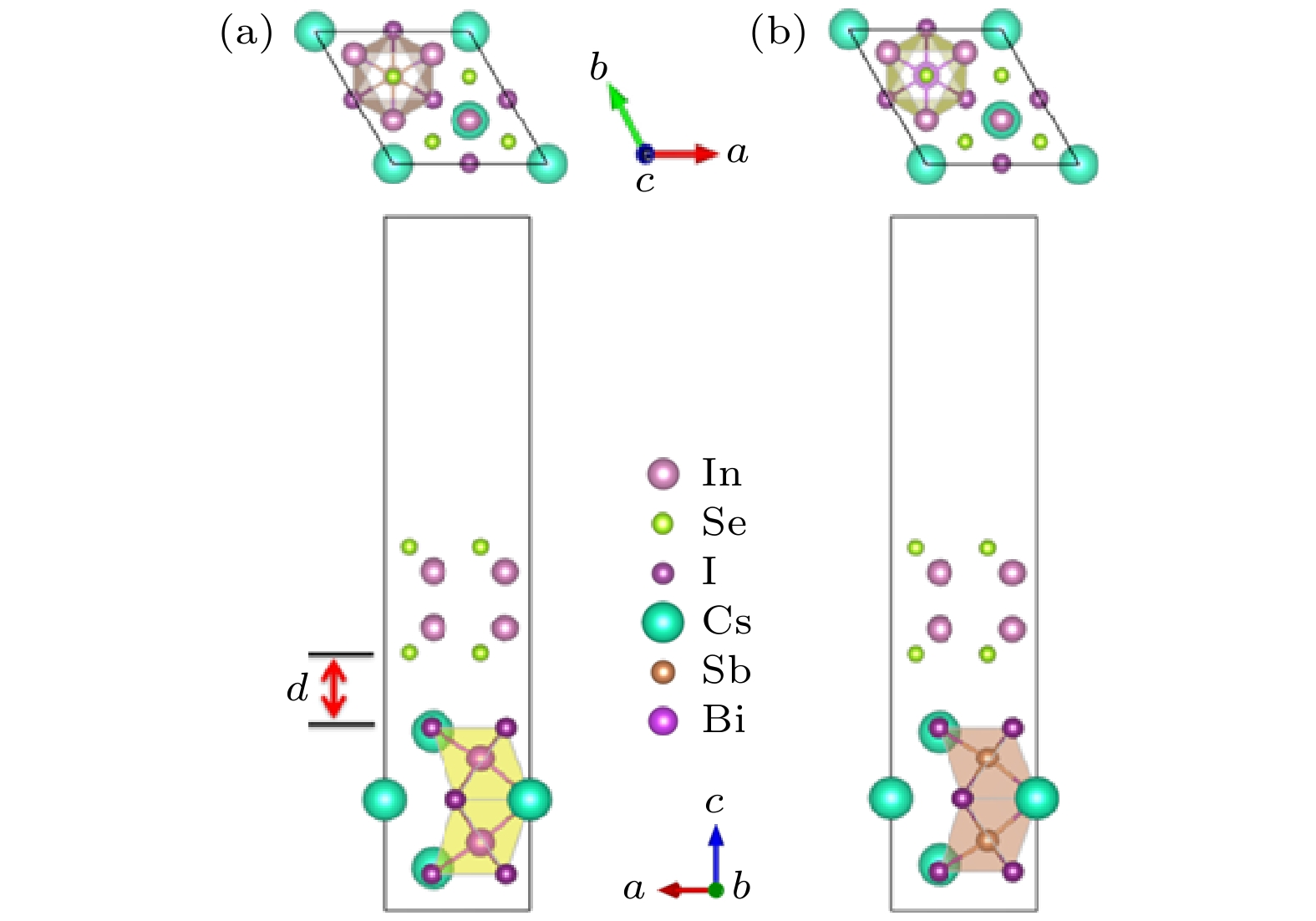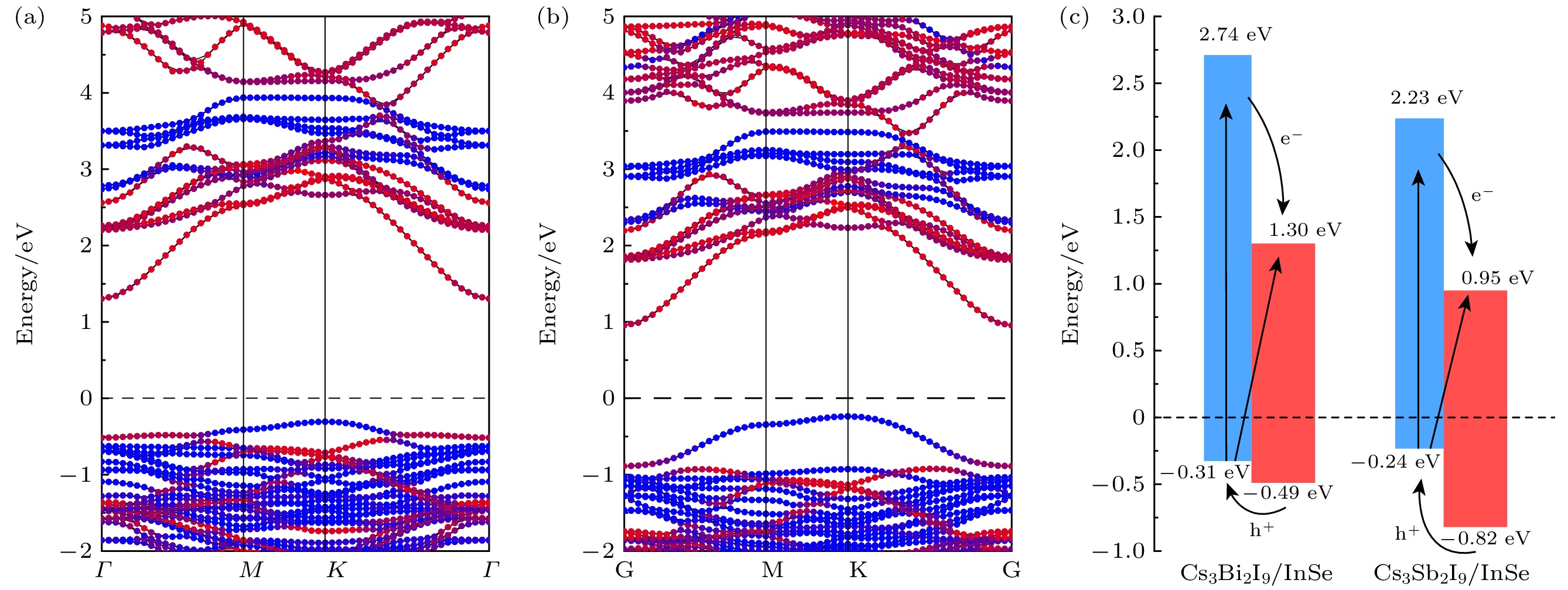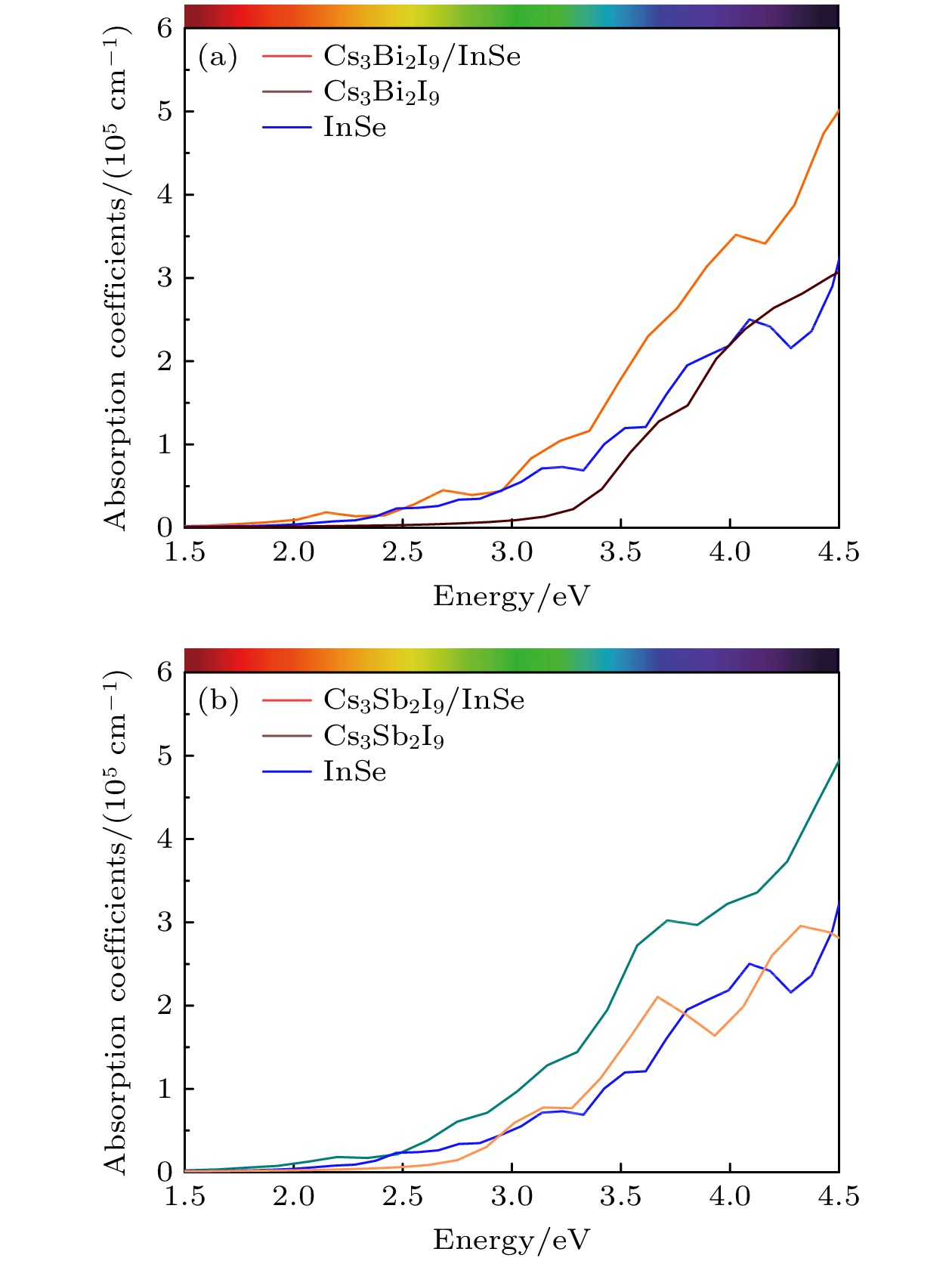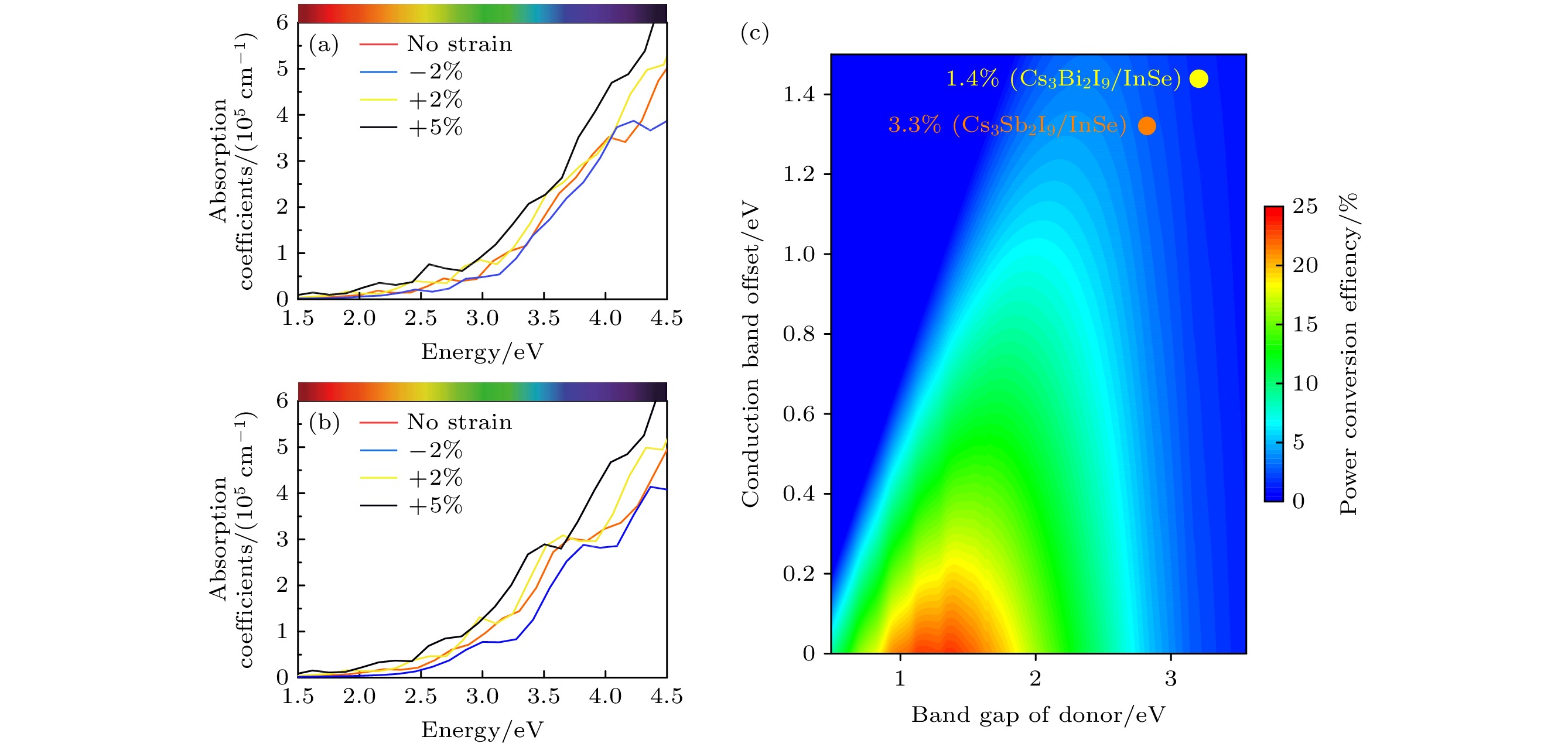-
设计二维半导体范德瓦耳斯异质结是一种实现多功能微电子器件的有效策略. 本文构筑了二维钙钛矿Cs3X2I9 (X = Bi, Sb)和铟锡InSe的范德瓦耳斯异质结Cs3X2I9/InSe. 基于密度泛函理论的第一性原理方法, 计算了其几何、电子结构、光学性质. 研究表明, 二维Cs3Bi2I9/InSe和Cs3Sb2I9/InSe异质结为II型能带排列, 且带隙分别为1.61 eV和1.19 eV, 可见光和紫外光范围内具有较高的吸收系数. 基于形变势理论和类氢原子模型的计算, 二维Cs3X2I9/InSe异质结显示了较高的电子迁移速率和激子结合能. 基于II型排列的能带结构和肖克利-奎伊瑟极限(Shockley-Queisser limit), 对比研究了光电转换效率. 此外, 进一步探究了双轴应变对二维异质结Cs3X2I9/InSe光电特性的调控及其规律. 上述研究为未来设计高效的二维范德瓦耳斯光电子器件提供了理论依据.Two-dimensional semiconductor heterostructures have excellent physical properties such as high light absorption coefficients, large diffusion lengths, high carrier mobility rates, and tunable energy band structures, which have great potential in the field of optoelectronic devices. Therefore, designing two-dimensional (2D) semiconductor van der Waals heterostructures is an effective strategy for realizing multifunctional microelectronic devices. In this work, the 2D van der Waals heterostructure Cs3X2I9/InSe of non-lead Perovskite Cs3X2I9 and indium-tin InSe is constructed to avoid the toxicity and stability problems of lead-based Perovskites. The geometry, electronic structure, and optical properties are calculated based on the first-principles approach of density-functional theory. It is shown that the 2D Cs3Bi2I9/InSe and Cs3Sb2I9/InSe heterostructures are of type-II energy band arrangement and have band gaps of 1.61 eV and 1.19 eV, respectively, with high absorption coefficients in the visible range and UV range reaching to 5×105 cm–1. The calculation results from the deformation potential theory and the hydrogen-like atom model show that the 2D Cs3X2I9/InSe heterostructure has a high exciton binding energy (~0.7 eV) and electron mobility rate (~700 cm2/(V·s)). The higher light absorption coefficient, carrier mobility, and exciton energy make the 2D Cs3X2I9/InSe heterostructures suitable for photoluminescent devices. However, the energy band structure based on the Shockley-Queisser limit and type-II arrangement shows that the intrinsic photoelectric conversion efficiency (PCE) of the 2D Cs3X2I9/InSe heterostructure is only about 1.4%, which is not suitable for photovoltaic solar energy. In addition, the modulation and its effect of biaxial strain on the photovoltaic properties of 2D Cs3X2I9/InSe heterostructures are further investigated. The results show that biaxial strain can improve the visible absorption coefficient of 2D Cs3X2I9/InSe heterostructure, but cannot effectively improve its energy band structure, and the PCE only increases to 3.3% at –5% biaxial strain. The above study provides a theoretical basis for designing efficient 2D van der Waals optoelectronic devices in future.
-
Keywords:
- 2D heterostructures /
- photoelectric conversion efficiency /
- first-principles calculations /
- strain engineering
[1] Xue M, Jiang F Y, Qin F, Li Z F, Tong J H, Xiong S X, Meng W, Zhou Y H 2014 ACS Appl. Mater. Interfaces 6 22628
 Google Scholar
Google Scholar
[2] Gu S, Lin R, Han Q, Gao Y, Tan H, Zhu J 2020 Adv. Mater. 32 1907392
 Google Scholar
Google Scholar
[3] Bernardi M, Palummo M, Grossman J C 2012 ACS Nano 6 10082
 Google Scholar
Google Scholar
[4] Zhang D B, Hu S, Liu X, Chen Y Z, Xia Y D, Wang H, Wang H Y, Ni Y X 2021 ACS Appl. Energy Mater. 1 357
 Google Scholar
Google Scholar
[5] Zhuang Q Y, Li J, He C Y, Yang T O, Zhang C X, Tang C, Zhong J X 2021 Nanoscale Adv. 3 3643
 Google Scholar
Google Scholar
[6] Gray H B 2009 Nat. Chem. 1 7
 Google Scholar
Google Scholar
[7] Lang Y F, Zou D F, Xu Y, Jiang S L, Zhao Y Q, Ang S Y 2024 Appl. Phys. Lett. 124 052903
 Google Scholar
Google Scholar
[8] Jeong J, Kim M J, Seo J D, Lu H Z, Ahlawat P, Mishra A, Yang Y G, Hope M A, Eickemeyer F T, Kim M, Yoon Y J, Choi I W, Darwich B P, Choi S J, Jo Y, Lee J H, Walker B, Zakeeruddin S M, Emsley L, Rothlisberger U, Hagfeldt A, Kim D S, Grätzel M, Kim J Y 2021 Nature 592 381
 Google Scholar
Google Scholar
[9] 陈亮, 张利伟, 陈永升 2018 物理学报 67 028801
 Google Scholar
Google Scholar
Chen L, Zhang L W, Chen Y S 2018 Acta Phys. Sin. 67 028801
 Google Scholar
Google Scholar
[10] 张钰, 周欢萍 2019 物理学报 68 158804
 Google Scholar
Google Scholar
Zhang Y, Zhou H P 2019 Acta Phys. Sin. 68 158804
 Google Scholar
Google Scholar
[11] Sun J C, Wu J, Tong X, Lin F, Wang Y A, Wang Z M 2018 Adv. Sci. 5 1700780
 Google Scholar
Google Scholar
[12] Jiang Y, Xu T F, Du H Q, Rothmann M U, Yin Z W, Yuan Y, Xiang W C, Hu Z Y, Liang G J, Liu S Z, Nazeeruddin M K, Cheng Y N, Li W 2023 Joule 7 2905
 Google Scholar
Google Scholar
[13] Tailor N K, Satapathi S 2020 ACS Appl. Energy Mater. 3 11732
 Google Scholar
Google Scholar
[14] Yu Z L, Zhao Y Q, Wan Q, Liu B, Yang J L, Cai M Q 2020 J. Phys. Condens. Matter. 32 205504
 Google Scholar
Google Scholar
[15] Zhang Z W, Liu Z S, Zhang J J, Sun B N, Zou D F, Nie G Z, Chen M Y, Zhao Y Q, Jiang S L 2023 Phys. Chem. Chem. Phys. 25 9548
 Google Scholar
Google Scholar
[16] Liao C S, Ding Y F, Zhao Y Q, Cai Q M 2021 Appl. Phys. Lett. 1 November 119 182903
 Google Scholar
Google Scholar
[17] Chen X K, Zhang E M, Wu D, Chen K Q 2023 Phys. Rev. Applied 19 044052
 Google Scholar
Google Scholar
[18] Chen X K, Hu X Y, Jia P, Xie Z X, Liu J 2021 Int. J. Mech. Sci. 206 106576
 Google Scholar
Google Scholar
[19] Chen X K, Zhang Y, Luo Q Q, Chen X, Jia P, Zhuo W X 2023 Phys. Rev. B 108 235420
 Google Scholar
Google Scholar
[20] Sun B, Ding Y F, He P B, Zhao Y Q, Cai M Q 2021 Phys. Rev. Applied 16 044003
 Google Scholar
Google Scholar
[21] Arfin H, Kshirsagar A S, Kaur J, Mondal B, Xia Z G, Chakraborty S, Nag A 2020 Chem. Mater 32 10267
 Google Scholar
Google Scholar
[22] Attique S, Ali N, Ali S, Khatoon R, Li N, Khesro A, Rauf S, Yang S K, Wu H Z 2020 Adv. Sci. 7 1903143
 Google Scholar
Google Scholar
[23] Zeng M Y, Zhao Y Q, Cai M Q 2021 Phys. Rev. Appl. 16 054019
 Google Scholar
Google Scholar
[24] Li J, Guo X Y, Hu X M, Wang W, Tai Y Y, Xie M, Zhi L, Zhang S L, Zeng H B 2023 Appl. Surf. Sci. 618 156626
 Google Scholar
Google Scholar
[25] Jin Z X, Zhang Z, Xiu J W, Song H S, Gatti T, He Z B 2020 J. Mater. Chem. A 8 16166
 Google Scholar
Google Scholar
[26] Li L J, Ye G, Luo T Y, Chen X Y, Zhang G J, Wu H, Yang L, Zhang W F, Chang H X 2022 J. Phys. Chem. C 126 3646
 Google Scholar
Google Scholar
[27] Oh J M, Venters C C, Di C, Pinto A M, Wan L L, Younis I, Cai Z Q, Arai C, So B R, Duan1 J Q, Dreyfuss G 2020 Nat. Commun. 11 1
 Google Scholar
Google Scholar
[28] Zhang J Y, Li A F, Li B H, Yang M M, Hao X, Wu L L, Zhao D W, Xia G P, Ren Z F, Tian W B, Yang D Y, Zhang J Q 2022 ACS Photonics 9 641
 Google Scholar
Google Scholar
[29] Li A F, Yang M M, Tang P, Hao X, Wu L L, Tian W B, Yang D Y, Zhang J Q 2023 ACS Appl. Mater. Interfaces 15 23390
 Google Scholar
Google Scholar
[30] Zhang H J, Xu Y D, Sun Q H, Dong J P, Lu Y F, Zhang B B, Jie W Q 2018 Cryst. Eng. Comm. 20 4935
 Google Scholar
Google Scholar
[31] McCall K M, Liu Z F, Trimarchi G, Stoumpos C C, Lin W W, He Y H, Hadar I, Kanatzidis M G, Wessels B W 2018 ACS Photonics 5 3748
 Google Scholar
Google Scholar
[32] Bresolin B M, Balayeva N O, Granone L I, Dillert R, Bahnemann D W, Sillanpaa M 2020 Sol. Energy Mater. Sol. C. 204 110214
 Google Scholar
Google Scholar
[33] Adams K, Mallows J, Li T Y, Kampouris D, Thijssen J B J, Robertson N 2019 J. Phys. Energy 1 034001
 Google Scholar
Google Scholar
[34] Cuhadar C, Kim S G, Yang J M, Seo J Y, Lee D, Park N G 2018 ACS Appl. Mater. Interfaces 10 29741
 Google Scholar
Google Scholar
[35] Hussain A A 2020 ACS Appl. Mater. Interfaces 12 46317
 Google Scholar
Google Scholar
[36] Tewari N, Shivarudraiah S B, Halpert J E 2021 Nano Lett. 21 5578
 Google Scholar
Google Scholar
[37] Li Y, Wang J H, Shen G Z 2022 Adv. Sci. 9 2202123
 Google Scholar
Google Scholar
[38] Yu Z L, Jia Y T, Lang L, Sun X X, Zou Z J, Li F, Zhao Y Q, Liu B, Li C, Liao G H 2023 J. Phys. : Condens. Matter 35 145501
 Google Scholar
Google Scholar
[39] 郭瑞, 魏星, 曹末云, 张妍, 杨云, 樊继斌, 刘剑, 田野, 赵泽坤, 段理 2022 化学学报 80 526
 Google Scholar
Google Scholar
Guo R, Wei X, Cao M Y, Zhang Y, Yang Y, Fan J B, Liu J, Tian Y, Zhao Z K, Duan L 2022 Acta Chim. Sinica 80 526
 Google Scholar
Google Scholar
[40] Yuan X J, Liu X J 2022 Phys. Chem. Chem. Phys. 24 17703
 Google Scholar
Google Scholar
[41] Yuan X J, Tang S H, Qiu S, Liu X J 2023 J. Phys. Chem. C 127 1828
 Google Scholar
Google Scholar
[42] Yu B B, Liao M, Yang J X, Chen W, Zhu Y D, Zhang X S, Duan T, Yao W T, Wei S H, He Z B 2019 J. Mater. Chem. A 7 8818
 Google Scholar
Google Scholar
[43] Zhao Y Q, Liu Z S, Nie G Z, Zhu Z H, Chai Y F, Wang J N, Cai M Q, Jiang S L 2021 Appl. Phys. Lett. 118 173104
 Google Scholar
Google Scholar
[44] Zhao Y Q, Xu Y, Zou D F, Wang J N, Xie G F, Liu B, Cai M Q, Jiang S L 2020 J. Phys. : Condens. Matter 32 195501
 Google Scholar
Google Scholar
[45] Sun G, Kutri J, Rajczy P, Kertesz M, Hafner J, Kresse G 2003 J. Molecular Structure: Theochem. 624 37
 Google Scholar
Google Scholar
[46] Perdew J P, Burke K, Wang Y 1996 Phys. Rev. B 54 16533
 Google Scholar
Google Scholar
[47] Ernzerhof M, Perdew J P 1998 J. Chem. Phys. 109 3313
 Google Scholar
Google Scholar
[48] Steinmann S N, Corminboeuf C 2011 J. Chem. Phys. 134 044117
 Google Scholar
Google Scholar
[49] Xia C X, Du J, Huang X W, Xiao X B, Xiong W Q, Wang T X, Wei Z M, Jia Y, Shi J J, Li J B 2018 Phys. Rev. B 97 115416
 Google Scholar
Google Scholar
[50] Gajdos G, Hummer K, Kresse G, Furthmuller J, Bechstedt F 2006 Phys. Rev. B 73 045112
 Google Scholar
Google Scholar
[51] Sun S S, Meng F C, Wang H Y, Wang H, Ni Y X 2018 J. Mater. Chem. A 6 11890
 Google Scholar
Google Scholar
[52] Cai Y Q, Zhang G, Zhang Y W 2014 J. Am. Chem. Soc. 136 6269
 Google Scholar
Google Scholar
[53] Dong S, Li Y C 2021 Phys. Rev. B 104 085133
 Google Scholar
Google Scholar
[54] Zhong F, Nie G Z, Lang Y F, Zhang Z W, Li H L, Gan L F, Xu Y, Zhao Y Q 2023 Phys. Chem. Chem. Phys. 25 3175
 Google Scholar
Google Scholar
[55] Choi J H, Cui P, Lan H P, Zhang Z Y 2015 Phys. Rev. Letters 115 066403
 Google Scholar
Google Scholar
[56] 江德生 2005 物理 34 521
 Google Scholar
Google Scholar
Jiang D S 2005 Physics. 34 521
 Google Scholar
Google Scholar
[57] Sun P P, Li Q S, Feng S, Li Z S 2016 Phys. Chem. Chem. Phys. 18 14408
 Google Scholar
Google Scholar
[58] Zhou L J, Zhang Y F, Wu L M 2013 Nano Lett. 13 5431
 Google Scholar
Google Scholar
[59] Hu W, Lin L, Zhang R Q, Yang C, Yang J L 2017 J. Am. Chem. Soc. 139 15429
 Google Scholar
Google Scholar
-
图 1 (a) Cs3Bi2I9/InSe 和(b) Cs3Sb2I9/InSe 的原子结构俯视和侧视图, 其中a和b为晶格矢量, d为 Cs3X2I9层和 InSe 层之间的层间距离
Fig. 1. Top and side views of the atomic structures for the (a) Cs3Bi2I9/InSe heterostructure, and (b) Cs3Sb2I9/InSe heterostructure, where a and b are the lattice vectors and d is the interlayer distance between the Cs3X2I9 and InSe layers.
图 3 (a) Cs3Bi2I9/InSe和(b) Cs3Sb2I9/InSe异质结的能带结构; (c) Cs3X2I9/InSe异质结的载流子迁移机制, 其中红色和蓝色分别代表InSe和Cs3X2I9的电子轨道贡献
Fig. 3. Band structures of (a) Cs3Bi2I9/InSe heterostructure and (b) Cs3Sb2I9/InSe heterostructure; (c) carrier migration mechanisms in Cs3X2I9/InSe heterostructures, the red and blue lines represent the electronic orbital contributions for InSe and Cs3X2I9, respectively.
表 1 二维 Cs3X2I9/InSe异质结的晶格常数(a, b)、层间距离(d)、激子结合能(Eb)、带隙(Gap)和晶格失配比(ε)
Table 1. Lattice constants (a, b), interlayer distances (d), exciton binding energy (Eb), band gap (Gap) and lattice mismatch ratio (ε) of 2D Cs3X2I9/InSe heterostructures.
Heterostructure Lattice/Å d/Å Eb/eV Gap/eV ε/% Cs3Bi2I9/InSe a = 8.32 3.71 0.79 1.61 1.89 b = 8.32 Cs3Sb2I9/InSe a = 8.30 3.77 0.73 1.19 1.61 b = 8.30 表 2 300 K下的电子和空穴沿x和y方向的有效质量m (m0)、DP常数E1 (eV)、二维弹性模量C2D (N/m)和载流子迁移速率μ2D (cm2·V–1·s–1)
Table 2. Effective masses m (m0), DP E1 (eV), 2D modulus of elasticity C2D (N/m) and carrier mobility μ2D (cm2·V–1·s–1) for electron and hole along and y directions at 300 K.
Carrier type mx my Elx Ely C2D_ x C2D_ y μ2D_ x μ2D_ y Electron Cs3Bi2I9/InSe 0.22 0.23 8.62 8.62 122.96 122.96 472.80 425.55 Cs3Sb2I9/InSe 0.24 0.22 7.13 7.13 125.76 123.22 619.99 692.30 Hole Cs3Bi2I9/InSe 1.16 0.97 6.43 6.43 122.96 122.96 31.39 44.32 Cs3Sb2I9/InSe 1.01 0.75 8.68 8.68 125.76 123.22 23.04 40.94 -
[1] Xue M, Jiang F Y, Qin F, Li Z F, Tong J H, Xiong S X, Meng W, Zhou Y H 2014 ACS Appl. Mater. Interfaces 6 22628
 Google Scholar
Google Scholar
[2] Gu S, Lin R, Han Q, Gao Y, Tan H, Zhu J 2020 Adv. Mater. 32 1907392
 Google Scholar
Google Scholar
[3] Bernardi M, Palummo M, Grossman J C 2012 ACS Nano 6 10082
 Google Scholar
Google Scholar
[4] Zhang D B, Hu S, Liu X, Chen Y Z, Xia Y D, Wang H, Wang H Y, Ni Y X 2021 ACS Appl. Energy Mater. 1 357
 Google Scholar
Google Scholar
[5] Zhuang Q Y, Li J, He C Y, Yang T O, Zhang C X, Tang C, Zhong J X 2021 Nanoscale Adv. 3 3643
 Google Scholar
Google Scholar
[6] Gray H B 2009 Nat. Chem. 1 7
 Google Scholar
Google Scholar
[7] Lang Y F, Zou D F, Xu Y, Jiang S L, Zhao Y Q, Ang S Y 2024 Appl. Phys. Lett. 124 052903
 Google Scholar
Google Scholar
[8] Jeong J, Kim M J, Seo J D, Lu H Z, Ahlawat P, Mishra A, Yang Y G, Hope M A, Eickemeyer F T, Kim M, Yoon Y J, Choi I W, Darwich B P, Choi S J, Jo Y, Lee J H, Walker B, Zakeeruddin S M, Emsley L, Rothlisberger U, Hagfeldt A, Kim D S, Grätzel M, Kim J Y 2021 Nature 592 381
 Google Scholar
Google Scholar
[9] 陈亮, 张利伟, 陈永升 2018 物理学报 67 028801
 Google Scholar
Google Scholar
Chen L, Zhang L W, Chen Y S 2018 Acta Phys. Sin. 67 028801
 Google Scholar
Google Scholar
[10] 张钰, 周欢萍 2019 物理学报 68 158804
 Google Scholar
Google Scholar
Zhang Y, Zhou H P 2019 Acta Phys. Sin. 68 158804
 Google Scholar
Google Scholar
[11] Sun J C, Wu J, Tong X, Lin F, Wang Y A, Wang Z M 2018 Adv. Sci. 5 1700780
 Google Scholar
Google Scholar
[12] Jiang Y, Xu T F, Du H Q, Rothmann M U, Yin Z W, Yuan Y, Xiang W C, Hu Z Y, Liang G J, Liu S Z, Nazeeruddin M K, Cheng Y N, Li W 2023 Joule 7 2905
 Google Scholar
Google Scholar
[13] Tailor N K, Satapathi S 2020 ACS Appl. Energy Mater. 3 11732
 Google Scholar
Google Scholar
[14] Yu Z L, Zhao Y Q, Wan Q, Liu B, Yang J L, Cai M Q 2020 J. Phys. Condens. Matter. 32 205504
 Google Scholar
Google Scholar
[15] Zhang Z W, Liu Z S, Zhang J J, Sun B N, Zou D F, Nie G Z, Chen M Y, Zhao Y Q, Jiang S L 2023 Phys. Chem. Chem. Phys. 25 9548
 Google Scholar
Google Scholar
[16] Liao C S, Ding Y F, Zhao Y Q, Cai Q M 2021 Appl. Phys. Lett. 1 November 119 182903
 Google Scholar
Google Scholar
[17] Chen X K, Zhang E M, Wu D, Chen K Q 2023 Phys. Rev. Applied 19 044052
 Google Scholar
Google Scholar
[18] Chen X K, Hu X Y, Jia P, Xie Z X, Liu J 2021 Int. J. Mech. Sci. 206 106576
 Google Scholar
Google Scholar
[19] Chen X K, Zhang Y, Luo Q Q, Chen X, Jia P, Zhuo W X 2023 Phys. Rev. B 108 235420
 Google Scholar
Google Scholar
[20] Sun B, Ding Y F, He P B, Zhao Y Q, Cai M Q 2021 Phys. Rev. Applied 16 044003
 Google Scholar
Google Scholar
[21] Arfin H, Kshirsagar A S, Kaur J, Mondal B, Xia Z G, Chakraborty S, Nag A 2020 Chem. Mater 32 10267
 Google Scholar
Google Scholar
[22] Attique S, Ali N, Ali S, Khatoon R, Li N, Khesro A, Rauf S, Yang S K, Wu H Z 2020 Adv. Sci. 7 1903143
 Google Scholar
Google Scholar
[23] Zeng M Y, Zhao Y Q, Cai M Q 2021 Phys. Rev. Appl. 16 054019
 Google Scholar
Google Scholar
[24] Li J, Guo X Y, Hu X M, Wang W, Tai Y Y, Xie M, Zhi L, Zhang S L, Zeng H B 2023 Appl. Surf. Sci. 618 156626
 Google Scholar
Google Scholar
[25] Jin Z X, Zhang Z, Xiu J W, Song H S, Gatti T, He Z B 2020 J. Mater. Chem. A 8 16166
 Google Scholar
Google Scholar
[26] Li L J, Ye G, Luo T Y, Chen X Y, Zhang G J, Wu H, Yang L, Zhang W F, Chang H X 2022 J. Phys. Chem. C 126 3646
 Google Scholar
Google Scholar
[27] Oh J M, Venters C C, Di C, Pinto A M, Wan L L, Younis I, Cai Z Q, Arai C, So B R, Duan1 J Q, Dreyfuss G 2020 Nat. Commun. 11 1
 Google Scholar
Google Scholar
[28] Zhang J Y, Li A F, Li B H, Yang M M, Hao X, Wu L L, Zhao D W, Xia G P, Ren Z F, Tian W B, Yang D Y, Zhang J Q 2022 ACS Photonics 9 641
 Google Scholar
Google Scholar
[29] Li A F, Yang M M, Tang P, Hao X, Wu L L, Tian W B, Yang D Y, Zhang J Q 2023 ACS Appl. Mater. Interfaces 15 23390
 Google Scholar
Google Scholar
[30] Zhang H J, Xu Y D, Sun Q H, Dong J P, Lu Y F, Zhang B B, Jie W Q 2018 Cryst. Eng. Comm. 20 4935
 Google Scholar
Google Scholar
[31] McCall K M, Liu Z F, Trimarchi G, Stoumpos C C, Lin W W, He Y H, Hadar I, Kanatzidis M G, Wessels B W 2018 ACS Photonics 5 3748
 Google Scholar
Google Scholar
[32] Bresolin B M, Balayeva N O, Granone L I, Dillert R, Bahnemann D W, Sillanpaa M 2020 Sol. Energy Mater. Sol. C. 204 110214
 Google Scholar
Google Scholar
[33] Adams K, Mallows J, Li T Y, Kampouris D, Thijssen J B J, Robertson N 2019 J. Phys. Energy 1 034001
 Google Scholar
Google Scholar
[34] Cuhadar C, Kim S G, Yang J M, Seo J Y, Lee D, Park N G 2018 ACS Appl. Mater. Interfaces 10 29741
 Google Scholar
Google Scholar
[35] Hussain A A 2020 ACS Appl. Mater. Interfaces 12 46317
 Google Scholar
Google Scholar
[36] Tewari N, Shivarudraiah S B, Halpert J E 2021 Nano Lett. 21 5578
 Google Scholar
Google Scholar
[37] Li Y, Wang J H, Shen G Z 2022 Adv. Sci. 9 2202123
 Google Scholar
Google Scholar
[38] Yu Z L, Jia Y T, Lang L, Sun X X, Zou Z J, Li F, Zhao Y Q, Liu B, Li C, Liao G H 2023 J. Phys. : Condens. Matter 35 145501
 Google Scholar
Google Scholar
[39] 郭瑞, 魏星, 曹末云, 张妍, 杨云, 樊继斌, 刘剑, 田野, 赵泽坤, 段理 2022 化学学报 80 526
 Google Scholar
Google Scholar
Guo R, Wei X, Cao M Y, Zhang Y, Yang Y, Fan J B, Liu J, Tian Y, Zhao Z K, Duan L 2022 Acta Chim. Sinica 80 526
 Google Scholar
Google Scholar
[40] Yuan X J, Liu X J 2022 Phys. Chem. Chem. Phys. 24 17703
 Google Scholar
Google Scholar
[41] Yuan X J, Tang S H, Qiu S, Liu X J 2023 J. Phys. Chem. C 127 1828
 Google Scholar
Google Scholar
[42] Yu B B, Liao M, Yang J X, Chen W, Zhu Y D, Zhang X S, Duan T, Yao W T, Wei S H, He Z B 2019 J. Mater. Chem. A 7 8818
 Google Scholar
Google Scholar
[43] Zhao Y Q, Liu Z S, Nie G Z, Zhu Z H, Chai Y F, Wang J N, Cai M Q, Jiang S L 2021 Appl. Phys. Lett. 118 173104
 Google Scholar
Google Scholar
[44] Zhao Y Q, Xu Y, Zou D F, Wang J N, Xie G F, Liu B, Cai M Q, Jiang S L 2020 J. Phys. : Condens. Matter 32 195501
 Google Scholar
Google Scholar
[45] Sun G, Kutri J, Rajczy P, Kertesz M, Hafner J, Kresse G 2003 J. Molecular Structure: Theochem. 624 37
 Google Scholar
Google Scholar
[46] Perdew J P, Burke K, Wang Y 1996 Phys. Rev. B 54 16533
 Google Scholar
Google Scholar
[47] Ernzerhof M, Perdew J P 1998 J. Chem. Phys. 109 3313
 Google Scholar
Google Scholar
[48] Steinmann S N, Corminboeuf C 2011 J. Chem. Phys. 134 044117
 Google Scholar
Google Scholar
[49] Xia C X, Du J, Huang X W, Xiao X B, Xiong W Q, Wang T X, Wei Z M, Jia Y, Shi J J, Li J B 2018 Phys. Rev. B 97 115416
 Google Scholar
Google Scholar
[50] Gajdos G, Hummer K, Kresse G, Furthmuller J, Bechstedt F 2006 Phys. Rev. B 73 045112
 Google Scholar
Google Scholar
[51] Sun S S, Meng F C, Wang H Y, Wang H, Ni Y X 2018 J. Mater. Chem. A 6 11890
 Google Scholar
Google Scholar
[52] Cai Y Q, Zhang G, Zhang Y W 2014 J. Am. Chem. Soc. 136 6269
 Google Scholar
Google Scholar
[53] Dong S, Li Y C 2021 Phys. Rev. B 104 085133
 Google Scholar
Google Scholar
[54] Zhong F, Nie G Z, Lang Y F, Zhang Z W, Li H L, Gan L F, Xu Y, Zhao Y Q 2023 Phys. Chem. Chem. Phys. 25 3175
 Google Scholar
Google Scholar
[55] Choi J H, Cui P, Lan H P, Zhang Z Y 2015 Phys. Rev. Letters 115 066403
 Google Scholar
Google Scholar
[56] 江德生 2005 物理 34 521
 Google Scholar
Google Scholar
Jiang D S 2005 Physics. 34 521
 Google Scholar
Google Scholar
[57] Sun P P, Li Q S, Feng S, Li Z S 2016 Phys. Chem. Chem. Phys. 18 14408
 Google Scholar
Google Scholar
[58] Zhou L J, Zhang Y F, Wu L M 2013 Nano Lett. 13 5431
 Google Scholar
Google Scholar
[59] Hu W, Lin L, Zhang R Q, Yang C, Yang J L 2017 J. Am. Chem. Soc. 139 15429
 Google Scholar
Google Scholar
计量
- 文章访问数: 5213
- PDF下载量: 200
- 被引次数: 0
















 下载:
下载:





